21.6: Noninfectious Diseases
- Last updated
- Save as PDF
- Page ID
- 22608
Apple Shape: Good for Apples, Bad for People
The person pictured in Figure \(\PageIndex{1}\) is obese. He has a lot of extra fat in his abdomen, giving him an apple shape. This type of fat distribution is called abdominal, or central, obesity. It is one of several indicators that are used to diagnose a condition called metabolic syndrome. Other indicators of metabolic syndrome include high blood pressure, high blood levels of glucose and triglycerides, and low blood levels of HDL (“good cholesterol”). Metabolic syndrome, in turn, is a major risk factor for many noninfectious disease killers.
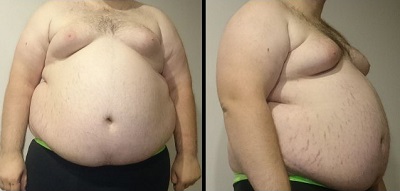
Introduction to Noninfectious Diseases
Noninfectious diseases include all diseases that are not caused by pathogens. Instead, noninfectious diseases are generally caused by genetic or environmental factors other than pathogens, such as toxic environmental exposures or unhealthy lifestyle choices. Most noninfectious diseases have a complex, multifactorial set of causes, often including a mix of genetic and environmental variables. Examples of noninfectious diseases include cystic fibrosis, most cancers, cardiovascular diseases such as coronary artery disease, and diabetes mellitus.
While many noninfectious diseases are long-lasting, or chronic, diseases, their chronicity is not a defining factor because some infectious diseases, such as AIDS, are also chronic diseases. In addition, some noninfectious diseases are short-term, or acute, diseases because they generally result in rapid death. Some types of cancer and heart disease are examples of noninfectious diseases that may be acute for this reason.
Noninfectious diseases have also been called diseases of affluence or lifestyle diseases because they are often caused by unhealthy lifestyle choices and first became prevalent in the richer nations of the world, while infectious diseases remained at relatively high levels in the poorer nations. Globally, noninfectious diseases are the leading causes of death. Although infectious diseases still cause more deaths in low-income countries, rates of death from noninfectious diseases are expected to rise in these countries as well. By 2030, noninfectious diseases are expected to kill more than 50 million people a year worldwide, and most of these deaths will occur not in high-income nations but in low- and middle-income countries. National economies around the world will also suffer significant losses because of the growing noninfectious disease burden, as noninfectious diseases cause a great deal of worker disability and premature death.
Risk Factors for Noninfectious Diseases
Many of the same risk factors increase a person’s chances of developing a diversity of noninfectious diseases. These common risk factors include age, gender, genes, and exposure to environmental dangers such as radon. Behaviors such as smoking, unhealthy diet, and physical inactivity are also common environmental risk factors for many noninfectious diseases. These behaviors all contribute to obesity, high blood pressure, unbalanced blood lipid levels, and high blood glucose levels — in other words, to metabolic syndrome. This syndrome, in turn, is a major risk factor for cardiovascular diseases and type 2 diabetes. One of the single most important behavioral factors contributing to metabolic syndrome is the consumption of large amounts of sweetened beverages such as soft drinks (Figure \(\PageIndex{2}\)).

Most behavioral risk factors for noninfectious diseases can be avoided. That’s why many noninfectious diseases are considered preventable. Their risk can be reduced by modifying behaviors and making healthier lifestyle choices. In fact, an estimated 80 percent of cases of cardiovascular diseases and type 2 diabetes and 40 percent of cancer cases could be avoided through lifestyle changes. Interventions that target common behavioral risk factors can make a big impact on a nation’s noninfectious disease burden. For example, laws taxing tobacco products and curbing smoking in public places have been shown to reduce rates of smoking, which is the main risk factor for lung cancer.
Other risk factors for noninfectious diseases — including age, gender, and genes — cannot be avoided or modified. In terms of age, most noninfectious diseases become more common as people get older. Some noninfectious diseases, such as certain types of cancer, are more common, or occur only, in one sex or the other. Genes are wholly responsible for some inherited noninfectious diseases, such as cystic fibrosis. Genes may also affect individual susceptibility to many other noninfectious diseases that are caused mainly by environmental factors. For example, genes may influence how likely a person is to develop metabolic syndrome for a given lifestyle, and ultimately how likely the person is to develop cardiovascular disease and type 2 diabetes. It is important to take these unavoidable risk factors into account in diagnosing and screening for noninfectious diseases and establishing individual treatment and prevention guidelines.
Examples of Noninfectious Diseases
Several examples of noninfectious diseases are described below. The diseases represent a diversity of types of diseases, ranging from purely genetic to primarily environmental diseases.
Cystic Fibrosis
Cystic fibrosis is an example of a genetic noninfectious disease. It is caused by an inherited mutation in a gene called CFTR. Mutant versions of the gene produce a faulty protein that normally helps to move sodium chloride into and out of cells. The impaired salt transfer causes mucus to be abnormally thick and sticky. Figure \(\PageIndex{3}\) helps explain the diversity of negative health impacts that may occur in people with cystic fibrosis. The thick mucus accumulates in the organs of the airways. This may lead to resurrect respiratory and sinus infections. This may also lead to malabsorption. The mucus blocks passages in mucus-secreting organs such as the lungs, pancreas, reproductive system, and intestine.
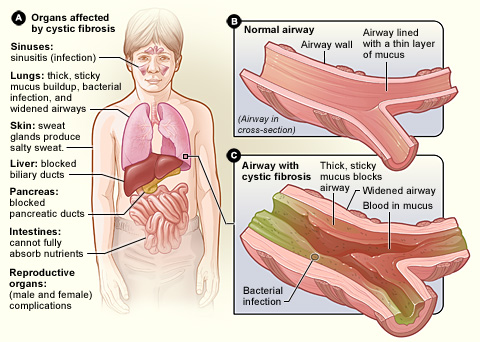
There is no known cure for cystic fibrosis, but recent advances in the treatment of cystic fibrosis allow people with the disease to live healthier and longer lives. A few generations ago, a newborn with cystic fibrosis was unlikely to live beyond the first year of life. Today, people with cystic fibrosis are likely to live to middle adulthood. Lung infections and other lung problems cause the greatest disability and premature death in people with cystic fibrosis. Therefore, treatment usually includes the proactive use of antibiotics and other drugs to fight off infections, along with pulmonary rehabilitation to maximize lung function. Even with treatment, however, lung damage may eventually progress to the point where a lung transplant is needed.
The mutant CFTR gene for cystic fibrosis is a recessive gene located on an autosome (chromosome 7). As with any autosomal recessive trait, an individual must have two copies of the mutant gene to develop the disease. An individual with just one copy of the normal CFTR gene can produce enough of the functioning protein to secrete normal mucus and avoid the signs and symptoms of cystic fibrosis. Such a person is called a carrier of cystic fibrosis. Carriers can pass the mutant gene to their offspring. The inheritance pattern of an autosomal recessive disease such as cystic fibrosis is shown in the pedigree diagram in Figure \(\PageIndex{4}\).
Without medical intervention, cystic fibrosis is fatal in infancy, yet the mutant gene that causes it has been maintained at relatively high levels in some human populations for tens of thousands of years. The mutant gene is most common in people of Northern European ancestry. In these populations, about 1 in 25 people is a carrier, and about 1 in 3,000 newborns have cystic fibrosis. The most common explanation for the persistence of the cystic fibrosis mutation is some type of heterozygote advantage in carriers of the mutant gene. For example, it has been hypothesized that carriers of the cystic fibrosis mutation may have greater-than-normal resistance to certain infectious diseases, such as cholera, typhoid fever, or tuberculosis.
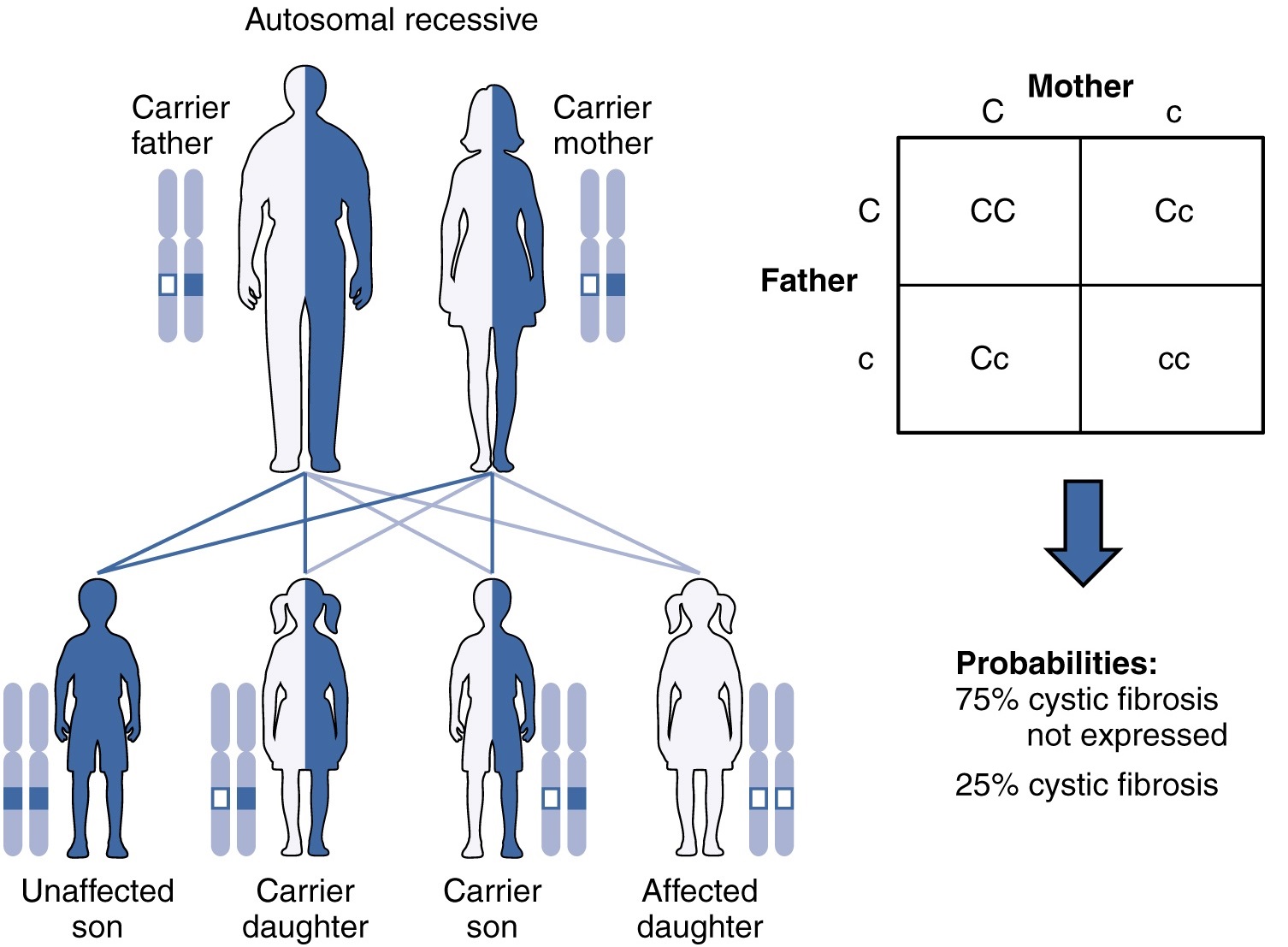
Cancer
Cancer is a group of diseases involving abnormal cell growth with the potential to invade or spread to other parts of the body. Cancer is one of the top ten causes of death in high-income countries. Most cancers are diagnosed in people over the age of 65; only a few types of cancer occur in children. It is likely that if one were to live long enough and avoid other common causes of death, such as cardiovascular diseases and diabetes, sooner or later a person would succumb to cancer.
About 90 percent of cancers are noninfectious diseases. (About 10 percent of cancers are infectious diseases caused by pathogens, such as the human papillomavirus, which causes cervical cancer.) Rather than pathogens, noninfectious cancers are caused by some combination of genetic and environmental factors. About 10 percent of cancers are caused largely by genes or have a very strong genetic influence. For example, inheriting genes called BRCA1 and BRCA2 increase the risk of women developing breast or ovarian cancer by as much as 75 percent.
Most cancers are caused largely by environmental factors, including human behaviors. For example, tobacco smoke contains 50 known carcinogens or cancer-causing agents, and smoking causes 90 percent of lung cancers. You can see the connection between smoking and lung cancer in Figure \(\PageIndex{5}\). Like most such environmental factors and cancer, it generally takes many years of exposure to tobacco smoke before lung cancer develops. Lung cancer is not the only kind of cancer caused by tobacco use. Smoking also increases the risk of cancer of the larynx, head, neck, stomach, bladder, kidney, esophagus, and pancreas.
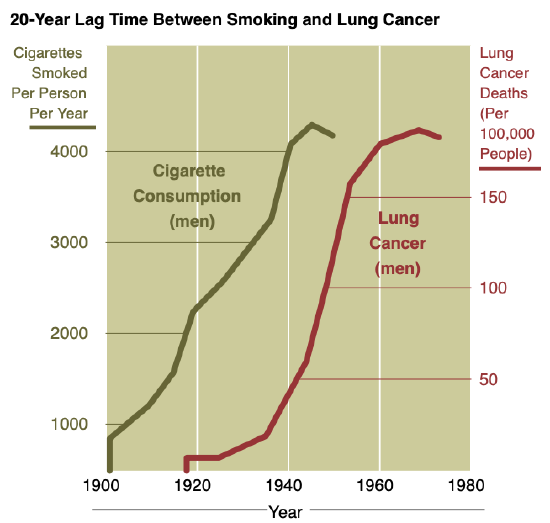
Other behaviors that play major roles in causing cancer include poor diet and physical inactivity, both of which contribute to high rates of obesity. These factors are responsible for at least a third of cancer deaths. Additional environmental causes of cancer include the radioactive gas radon from underground rocks and ultraviolet radiation from the sun. Radon increases lung cancer risk, and UV radiation is the primary cause of skin cancer.
Many treatment options exist for cancer. The primary treatments include surgery, chemotherapy, and radiation therapy. Which treatments are used depends on factors such as the type and location of cancer and whether cancer has spread. Treatments may or may not be curative. You can learn more about cancer by reading the concept of Cancer.
Cardiovascular Disease
Cardiovascular disease refers to a class of diseases that involve the heart or blood vessels. The diseases include coronary artery disease, stroke, and peripheral artery disease. (You can read more about specific types of cardiovascular disease in the concept of Cardiovascular Disease.) Cardiovascular disease is the leading cause of death worldwide, with about 30 percent of deaths attributable mainly to cardiovascular disease. By the year 2030, an estimated 23 million people a year will die from cardiovascular disease.
Two major precursors of cardiovascular disease are hypertension and atherosclerosis.
- Hypertension is defined as blood pressure that is persistently elevated. Controlling hypertension either through medications or lifestyle changes is important for reducing the risk of all types of cardiovascular diseases, but especially stroke.
- Atherosclerosis is a condition in which artery walls thicken and stiffen as a result of the buildup of fatty plaques inside the arteries (Figure \(\PageIndex{6}\)). The buildup of plaques in arteries actually starts in childhood and continues in most people throughout life. The progression of atherosclerosis can be controlled through lifestyle approaches, including eating a healthy diet, getting regular exercise, and avoiding tobacco smoke. Medications to lower blood triglycerides and raise HDL levels may also help.
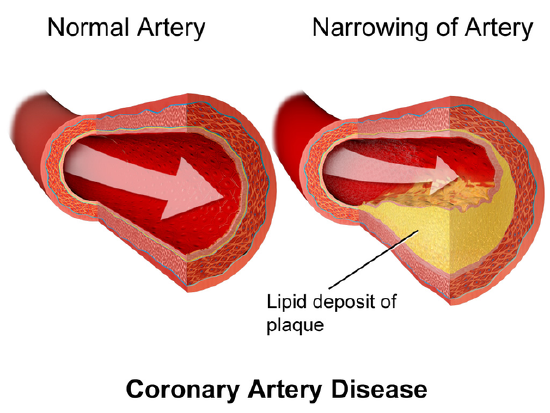
Obesity and diabetes are additional major risk factors for cardiovascular disease. Obesity is associated with other risk factors for cardiovascular disease, including hypertension and high blood triglycerides, but it may also have an independent effect on cardiovascular disease risk. People with diabetes are two to four times more likely than nondiabetics to die of cardiovascular disease.
Most cases of cardiovascular disease could be prevented by modifying risk factors. Some risk factors, such as hypertension and high blood triglycerides, can be controlled with medications. Other risk factors, such as obesity and physical inactivity, can be controlled by adopting healthy behaviors (such behaviors may also help control hypertension and high blood lipids even without medications). Although modifiable environmental factors such as these are the main risk factors for cardiovascular disease, genes also play an important role. A person’s risk of developing cardiovascular disease is three times greater than the average if the person’s parents had cardiovascular disease. However, age is by far the most important risk factor for diseases of the heart or arteries. There is a tripling of cardiovascular disease risk with each passing decade of life.
Type 2 Diabetes
Diabetes is diagnosed in people who have abnormally high levels of blood glucose over prolonged periods of time. Symptoms of untreated high blood glucose include frequent urination, increased thirst, and increased hunger. As of 2016, an estimated 422 million people worldwide had diabetes, with the rates being somewhat higher in developed countries.
There are several types of diabetes, but type 2 diabetes is by far the most common. It accounts for about 90 percent of all cases of diabetes. Type 2 diabetes generally develops due to insulin resistance, rather than lack of insulin, which occurs in type 1 diabetes. As illustrated in Figure \(\PageIndex{7}\), insulin resistance occurs when cells of the body become increasingly unresponsive to insulin due to malfunctioning insulin-receptor sites. Cells can no longer take up enough glucose from the blood to maintain glucose homeostasis. In many cases of type 2 diabetes, the problem of insulin resistance is exacerbated by a secondary reduction in insulin secretion.
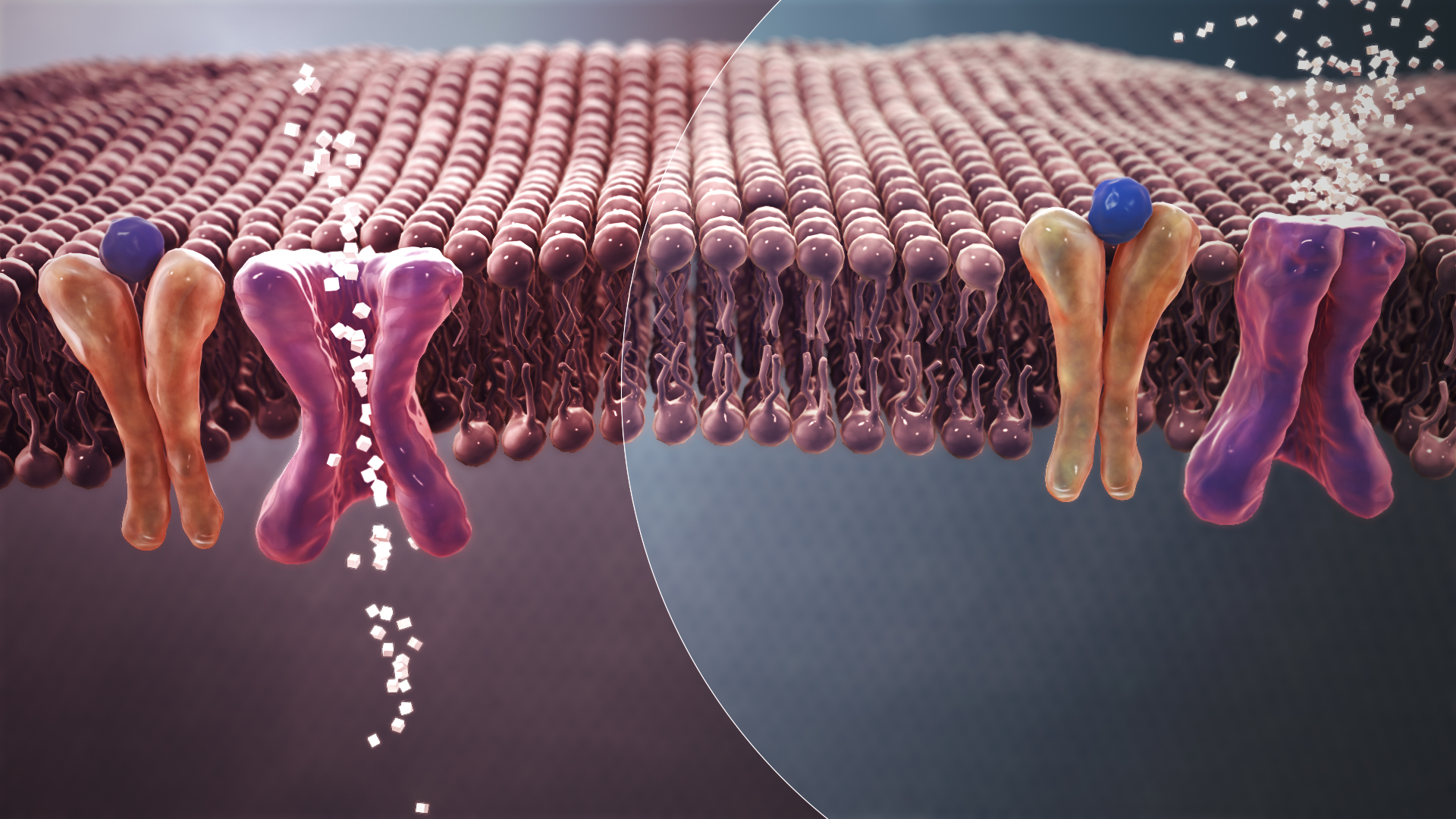
Figure \(\PageIndex{7}\): The mechanism that underlies most type 2 diabetes is insulin resistance, which leads to elevated levels of glucose in the blood. On the left, it shows two receptors piercing through the plasma membrane of a cell. The blue ball represents insulin which is attached to its receptor. This attachment is necessary for the glucose channels to open. The glucose is flowing into the cell through open glucose channels. On the right, you see the same types of receptors. Insulin is attached to its receptor, but it is not causing the glucose channels to open. This leads to the accumulation of glucose in the blood.
Type 2 diabetes typically starts after the age of 40. It is most likely to be diagnosed in people who are obese and have other indicators of metabolic syndrome, which is sometimes referred to as pre-diabetes for this reason. Because of the dramatic increase in recent decades in obesity in younger people, the age at which type 2 diabetes is diagnosed has fallen. Even children are now being diagnosed with type 2 diabetes. Today, about 30 million Americans have type 2 diabetes, and another 90 million Americans have pre-diabetes.
Unless diabetes is carefully monitored and controlled, high blood sugar levels can eventually lead to heart attacks, strokes, blindness, kidney failure, and many other serious health problems. These complications of diabetes are primarily due to damage to small blood vessels caused by inadequately controlled blood glucose levels. All else being equal, the risk of death in adults with diabetes is 50 percent greater than it is in adults without diabetes.
Controlling type 2 diabetes usually requires frequent blood glucose testing, watching what and when you eat and taking oral medications or even insulin injections. Changing your lifestyle may stop the progression of type 2 diabetes or even reverse it. By adopting healthier behaviors, you may be able to keep your blood glucose level within the normal range without medications or insulin.
Review
- Define noninfectious disease.
- In general, what causes noninfectious diseases?
- Identify risk factors for noninfectious diseases.
- Why are many noninfectious diseases considered preventable diseases?
- What noninfectious disease risk factors cannot be avoided? Why are these risk factors still important to identify?
- What is cystic fibrosis?
- How does the cystic fibrosis mutation cause disease?
- Define cancer.
- What causes most cancers?
- List three types of treatment for cancer.
- What is a cardiovascular disease? What is its significance as a cause of death worldwide?
- Identify major precursors and risk factors for cardiovascular disease.
- What causes type 2 diabetes?
- Identify risk factors for type 2 diabetes.
- List possible health problems that can result from poorly controlled diabetes.
- Could metabolic syndrome ultimately result in kidney failure? Explain your answer.
Explore More
Attributions
- Obesity by FatM1ke, Public Domain via Wikimedia Commons
- Double big gulp by Russell Bernice from New York City, U.S., CC BY 2.0 via Wikimedia Commons
- Cystic Fibrosis by National Heart Lung and Blood Institute (NIH), Public Domain via Wikimedia Commons
- Autosomal Recessive Inheritance by OpenStax College CC BY 3.0
- Smoking and Lung Cancer Correlation by Sakurambo, Public Domain via Wikimedia Commons
- Coronary Artery Disease by Blausen.com staff (2014). "Medical gallery of Blausen Medical 2014". WikiJournal of Medicine 1 (2). DOI:10.15347/wjm/2014.010. ISSN 2002-4436. CC BY 3.0 via Wikimedia Commons
- Insulin Resistance by Manu5, CC BY 4.0 via Wikimedia.org
- Text adapted from Human Biology by CK-12 licensed CC BY-NC 3.


